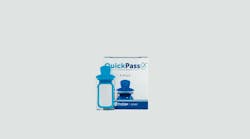3 easy steps if you fail a dental unit waterline test
Listen to the article on our podcast!
No one likes to fail, especially us type-A dental folks. But if you find yourself on the failing end of a dental unit waterline (DUWL) test, don’t freak out. In fact, I want to congratulate you on actually testing. While there is no published data, industry experts estimate that only 15%–30% of offices follow a proper testing protocol. Testing is the only way to know if your waterline protocol is actually working or not!
Contaminated DUWLs have been linked to severe infections in patients and, in a few cases, death. New research shows that up to 78% of the aerosols we create in the operatory come directly from our procedural water, so our health is at stake, too.
Thankfully, remediation isn’t that hard. Think of it like when your patients come in with uncharacteristic bleeding and inflammation. That biofilm is out of control in their mouth, and it’s time to get everything back on track. Follow these three simple steps to enable your operatory to pass the test.
Step 1: Shock
Shocking means using a strong antimicrobial to blast away the biofilm in your DUWL. There are lots of great shock products. The most important thing is to read and follow the instructions for use (IFU). Run the shock product into every line that can receive water, especially if you don’t use it regularly. That line could be the source of your contamination because the water is sitting stagnant and allowing the biofilm to grow undisturbed. Leave it in for the recommended amount of time, and then flush it out with a few bottles of warm water.
Step 2: Retest
After shocking, retest your lines. There are chairside tests and mail-in tests. Just like with your shock product, pay attention to the IFUs. I often move from pooled sampling, where you sample equal amounts from all the lines in one operatory, to individual line testing. This helps me isolate the problem line. However, pooled sampling is still acceptable. Be sure to document your results. If it’s a chairside test, take a picture. Experts recommend testing monthly until you pass two consecutive months. Create a reminder to test again in a month. If you fail again, go back to step one and shock.
Step 3: Evaluate
Once you pass, it’s time to figure out what went wrong. There isn’t always a clear answer for why a line failed. Sometimes, it’s as simple as shocking more often. But a good place to start is to review your waterline protocol with the whole team. Ensure everyone is performing the standard operating procedures every time.
If that’s not it, check to see if there’s a “dead leg.” This is the line I mentioned when shocking, the one that can get water but doesn’t get used. Call a service tech and have them cap off that line so it’s no longer a trouble spot; otherwise ensure it’s flushed and shocked regularly. The issue could be your source water. What are you filling your bottles with? Is that water already full of microbes? Test your source water. Also, check your unit water bottle. Biofilm can grow there. Most IFUs recommend cleaning and replacing your bottle at certain intervals.
If you keep failing, you might need to call the experts. The Water Safety Experts at ProEdge Dental Water Labs are there to help you no matter what products you use. Call them at (888) 843-3343 or email [email protected] to help you pass the test!
Editor's note: This article appeared in the Aug/Sept 2024 print edition of RDH magazine. Dental hygienists in North America are eligible for a complimentary print subscription. Sign up here.
About the Author

Amanda Hill, BSDH, RDH, CDIPC
Amanda Hill, BSDH, RDH, CDIPC, is an enthusiastic speaker, innovative consultant, and award-winning author who brings more than 25 years of clinical dental hygiene and education to dentistry. Recipient of ADS’s Emerging Infection Control Leader award and an active participant with the advisory board for RDH magazine, DentistryIQ, and ADS’s Infection Control in Practice Editorial Review Board and membership committee, Amanda (also known as the Waterline Warrior) strives to make topics in dentistry accurate, accessible, and fun. She can be reached at [email protected].


